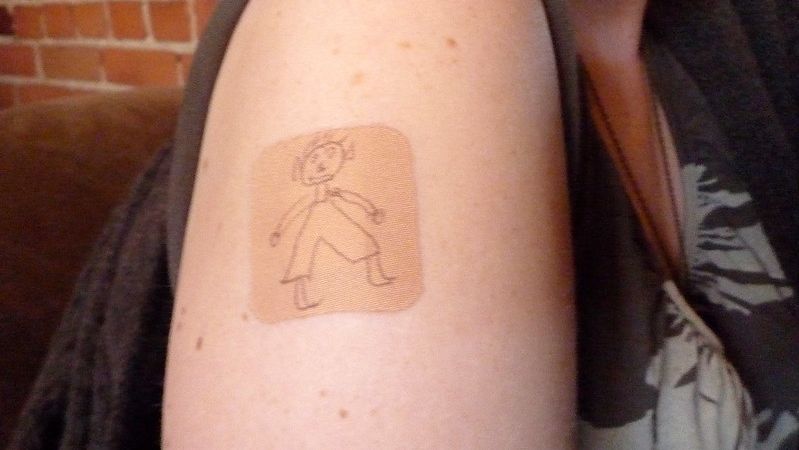Fear of Needles

*No images of needles are on this page.
A fear of needles is very common among adults and this fear can be quite pervasive during pregnancy, especially as pregnancy usually requires numerous different types of injections as routine care.
However, fear and anxiety regarding screening tests, vaccinations, and intravenous medication should not be trivialized, and women with a moderate to severe level of needle fear need to find an HCP who understands, appreciates, and empathizes with their concerns.
Women should not feel that any routine test requiring blood work is mandatory. Pregnant women need to have a risks and benefits conversation regarding each type of screening test or vaccination recommended by their HCP.
All efforts should be made to provide the woman excellent health care with the least amount of needle exposure. Further, even when an injection may be necessary, there are several methods and techniques that can be used to alleviate fear and pain (read below).
Background
Women who are afraid of needles – even on a moderate level – are vulnerable during pregnancy, as this is a particular health condition that can require repeated injections.
A fear of needles (trypanophobia) is incredibly common among adults (up to 30%) and tends to be more prevalent in women. This fear can carry over into pregnancy – a time in which women are advised to provide numerous blood/lab tests. Therefore, a fear of needles can become problematic during pregnancy if women choose to avoid certain screening tests or procedures.
Individuals with a high degree of needle fear associate injections and blood work with a significant level of pain and anxiety. Although not specifically studied during pregnancy, these feelings may lead some women to refuse blood and screening tests, epidurals, and intravenous medication during labor and delivery; and in extreme cases, women may even avoid pregnancy.
Although needle fear is normal, and the procedures that involve needles are very quick, the condition should not be trivialized by either a woman’s HCP, nursing staff, or lab technicians.
Women need to find an HCP who understand their concerns, has risks and benefits discussions about each procedure, screening test, and vaccination, and does not dismiss the woman or her fears.

Management Overview
As much as HCPs and those who support pregnant women want to help them overcome their fear, there is a lack of information and clinical research regarding the best management method, and therefore, more research is necessary.
However, women need to be taken seriously, and there are varying ways to manage women’s fears and perception of pain; unfortunately, some reviews have determined these methods are not often applied for those who need them.
Knowledge
First, although information does not necessarily take away pain, if women are better educated on the purpose of a screening test, procedure, or vaccination, it may help them have less fear, anxiety, or sense of loss of control, or that they are being "forced" into a procedure.
It is important that women do not get overwhelmed; they need to take one test at a time, and make sure they have all the information available to them about the necessity, risks, and benefits of each procedure.
Needle fears are a known contributor to vaccine avoidance; there are two vaccines routinely advised during pregnancy – seasonal influenza and Tdap, both of which are recommended in the second or third trimester. Other vaccines are recommended based on a woman’s risk factors. Women can learn about why these vaccines are recommended here.
Blood work is often required during pregnancy, but only requires one needle exposure each time, not for each test/screening (meaning only one injection for multiple tests).
Blood work may be requested early in pregnancy at the first prenatal appointment to confirm a pregnancy and check the mother’s overall health status, at the start of the second trimester, and around 20 weeks of pregnancy, which is based on screening test recommendations. Women can read more about screening tests here.
A glucose screening test – which checks for gestational diabetes mellitus – is recommended between 24 and 28 weeks of pregnancy. This test would require two needle exposures about an hour apart; however, women with a high degree of needle fear can discuss their options with their HCP.
HCPs may be able to request specific blood work during the first trimester (HbA1c) that coincides with other blood work. It may not fully replace a glucose screening, but if women are considered low risk for GDM, this method may be possible (read more).
Women who are afraid of needle procedures but are also concerned about labor pain may also have extreme anxiety regarding epidurals and how they are placed. Women should read more on epidurals for detailed information on the procedure and how it may feel.
During labor, women often receive intravenous (IV) fluids or medication; upon admission, some women may be given an IV injection that is taped to the hand/arm so it is available if fluids or medication become necessary (the needle is removed, and a flexible catheter stays in place).
Although debated on whether it is necessary, having the catheter in place can save time in the event the following may be needed: pain medication, oxytocin (possible bleeding after placental removal), fluids, and/or glucose and sodium to keep women hydrated during lengthy labors.
Injection Pain Relief
Smaller needles
Women can ask nursing staff and lab technicians to use the smallest/thinnest needle possible that will still collect or administer the necessary medication/blood sample.
For example, smaller needle diameters and lower insertion forces have been shown to reduce the frequency of painful injections. This has led to the development of much finer needles to minimize pain. However, smaller, fine, or microneedles are not appropriate for all procedures.
Numbing Agents
Using ice to cool/numb the site prior to an injection is an effective and inexpensive method to reduce pain from an injection.

Lidocaine cream is also available by prescription, which can numb the skin prior to an injection (after the “spot” has been identified). This type of cream works best 30 to 60 minutes prior to injection.
According to the medication leaflet, EMLA® (Eutectic Mixture of Local Anesthetics) Cream contains two local anesthetics called lidocaine and prilocaine. EMLA® cream works by numbing the surface of the skin for a short time prior to certain medical procedures.
Although not specifically studied during pregnancy, occasional use of EMLA® cream during pregnancy is not expected to have any adverse effects on the fetus. However, women need to talk to their HCP about using this cream during pregnancy, and make sure to follow all instructions for using the medication properly.
Exposure and Tension
Exposure to a stimulus that causes fear/anxiety in individuals (such as a needle) is a psychological intervention that is considered highly effective for certain phobias. Exposure therapy helps individuals realize that the stress related to their fear can be manageable and is unlikely to cause them real harm.
Further, most individuals with high needle fears or phobias can usually root their fear back to one traumatic needle procedure when they were younger. Exposure can help individuals realize that not every needle stick/injection results in a strongly negative experience.
It is recommended that individuals with a fear of needles be exposed to them gradually, and in a hierarchical manner. Depending on the severity of fear, exposure can begin with first sitting in a waiting room, to seeing a syringe without a needle, to seeing a syringe with a needle, then holding it, then potentially receiving an injection.

Additionally, although most individuals who fear needles tend to look away during an injection, it may be helpful for some individuals to not only be shown the needle prior to injection, but to watch as well so the injection does not result in a “surprise” or “panic” response. In at least one study, adults who chose to look at the needle going into their arm reported less pain compared with those who chose to look away.
If helpful, technicians who perform needle-procedures can describe how they will use proper technique and answer any questions a woman may have regarding the injection. Technicians can also offer “rehearsals” of sorts so the woman knows what to expect and can practice breathing, such as a forceful exhale during the injection itself.
Exposure may be more beneficial when practiced together with applied tension.
Muscle tension is a technique in which individuals tense their muscles (abs, legs, arms) to raise their blood pressure to combat a vasovagal response (such as impending signs of stress, fainting, or dizziness); this muscle tension is called “applied” tension when it is used while being exposed to the fear.
The Valsalva maneuver uses muscles slightly differently to achieve a pain-minimizing effect. This technique is similar to an individual "bearing down", blowing up a balloon (resistance), or straining/pushing for a bowel movement.
This maneuver increases blood pressure as well as general pressure in the chest. It is thought to work because increasing blood pressure causes baroreceptor activation, which induces a process that can block feelings of pain.
Action
Women should not feel any routine test requiring blood work is mandatory. Pregnant women need to have a risks and benefits conversation regarding each type of screening test or vaccination recommended by their HCP.
All efforts should be made by HCPs to provide women excellent health care with the least amount of needle exposure.
Women should also ask their HCP at their first appointment when they can expect any/all needle-based procedures throughout their pregnancy so they can be fully prepared and not surprised, which can induce panic.
No one should make women feel they have to “get over it” – however, learning various management techniques can help them through it:
In addition to the above (ice, numbing agents, pressure), women need to tell the lab technician/nurse they are afraid of needles and are also pregnant; office staff need to ensure the woman is safe from falling in the event she faints, as this could be dangerous during pregnancy.
Women should also ask for a technician with experience working with individuals with needle phobia, and one with plenty of experience in general.
Women should also be aware of a product called Buzzy® (no affiliation). The device is shaped like a bumblebee and is designed to both vibrate and feel cold; the goal of the product is to block nerve pain transmission when placed at a certain location near the injection site. Although technically designed for children, it is relatively inexpensive for its potential benefit and may work well for pregnant women.
Women should also consider sharing and submitting their experience below regarding their fear of needles during pregnancy. This can help other women learn additional perspectives regarding this concern and how to potentially handle this fear during pregnancy.
Resources
EMLA cream Fact Sheet (University of Wisconsin-Madison)
Interventions for Individuals With High Levels of Needle Fear: Systematic Review of Randomized Controlled Trials and Quasi-Randomized Controlled Trials (Clin J Pain. October 2015)